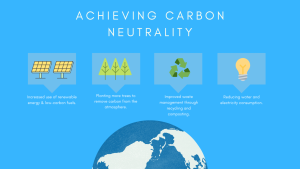COVID-19 offers chance to revitalize the planet — or destroy it
Carbon emissions have plummeted due to shelter-in-place orders, but we must enact change now, before they are lifted — before it is, once again, too late.
May 3, 2020
As people retreat into their homes worldwide, the earth takes a huge sigh of relief.
Stay-at-home orders and restrictions of unnecessary activity have brought an unprecedented breakdown in human activity: suddenly, every movement counts. Suddenly, one step out the door has the ability to send endless realities crashing down.
With decreased road and air travel and the shutdown of economic activity, fossil fuel emissions have slowed dramatically. Big cities are finally seeing clear skies. The canals of Venice have become translucent — and while the dolphins seen in them were false, it’s true that jellyfish are now visible in the canal’s waters. China, hard-hit by the pandemic, saw its carbon emissions drop by a stunning 25% in February alone (CarbonBrief); meanwhile, the United States saw a similar 15-20% drop in one month.
On the surface, positive climate change results seem like the only silver lining to the coronavirus. It’s tempting to portray it as a beacon of hope amidst all the despair, but as long as the pandemic is temporary, these results will be too.
Individuals may change their habits as a result of the pandemic — buying only the essentials, taking different means of transportation — but as Meehan Crist pointed out in her New York Times article, “What the Coronavirus Means for Climate Change,” individual consumption (12% of greenhouse gas emissions, according to the U.S. Environmental Protection Agency) is modest compared to that of large-scale corporations (27%). And that consumption is once again on the rise.
Already, President Trump speaks of reopening the economy and loosening shelter-in-place orders throughout the country. After all, millions of Americans have filed for unemployment, and stock markets have suffered plunges to parallel those of the Great Depression. In desperate attempts to resurrect the economy, governments will likely relax environmental regulations on companies.
Traditional regulations like fuel efficiency and emissions standards, which are essential for long-term greenhouse gas reductions — and, in turn, the future of the planet — could be thrown down the drain. Not only would this negate any progress made so far, carbon emissions may even exceed pre-pandemic expectations.
None of this is good news, especially when confronted with the hard data. In order to prevent global temperatures from rising 1.5 degrees Celsius this decade, scientists say that emissions need to drop by 7.6%.
The COVID-19 pandemic is only predicted to cover 5% of the decline. And at this very moment, global emissions are already reviving.
A case study is China: after its 25% drop in carbon emissions in February, rates are already rebounding as it resumes manufacturing with more vigor than ever before. The Chinese government’s eager efforts, which include a stimulus package to fund large-scale infrastructure projects, foreshadow the future path of the United States.
Crist points out other problems in her article: companies developing clean energy have undergone financial and project cuts (especially when the majority of solar panels, wind turbines and lithium-ion batteries are made in China); falling oil prices encourage increased oil usage; lockdowns have disrupted climate research worldwide; and governments will be able to use the pandemic as a valid excuse for exceeding Paris Agreement pledges (as the Czech Republic has demonstrated by setting aside the European Green Deal).
The impacts of one crisis can’t be allowed to cascade into and magnify another. Solving the coronavirus pandemic with hasty, short-term measures will only aggravate the effects of a longer, less noticeable, but just as notable crisis.
“What we need is to… create unbearable pressure for our politicians and institutional leaders and turn this ship around radically and as soon as possible,” Margaret Klein Salamon, founder and executive director of the Climate Mobilization, said.
An unprecedented pandemic needs an unprecedented solution. From April 27 to 28, environmental ministers from 30 countries met (online, with a public livestream) for the 11th Petersberg Climate Dialogue. Discussion revolved around plans for economic revival using eco-friendly measures. Unfortunately, it seems that the United States was absent from the discussion.
“When we emerge from the coronavirus pandemic, we must focus on supporting a clean, inclusive, and resilient recovery, building on the principles of the Paris Agreement and Sustainable Development Goals,” said Alok Sharma, minister of the 26th United Nations Climate Change Conference and co-host of the Dialogue. “We do not have time to waste.”
Multiple options have already been tabled. The most promising appears to be investment in renewable energy, which would provide desperately needed economic boosts while combating climate change.
“Governments are facing a difficult task of bringing the health emergency under control while introducing major stimulus and recovery measures,” Francesco La Camera, director of the International Renewable Energy Agency, said in a Guardian article. “By accelerating renewables … governments can achieve multiple economic and social objectives in the pursuit of a resilient future that leaves nobody behind.”
The COVID-19 pandemic has given us a glimpse into a world with lower emissions. It offers a window of possibility for the future — an opportunity to revitalize the earth in unparalleled ways, and to simultaneously create a vibrant economy and healthier planet. Ill-advised measures could do just the opposite. The possibility, however, is certain: there is hope for a green economic recovery.




